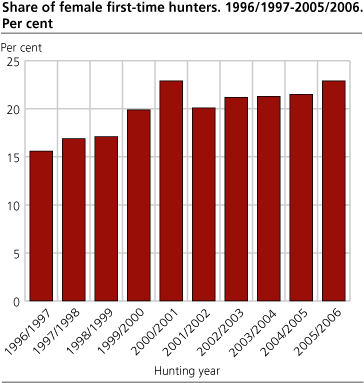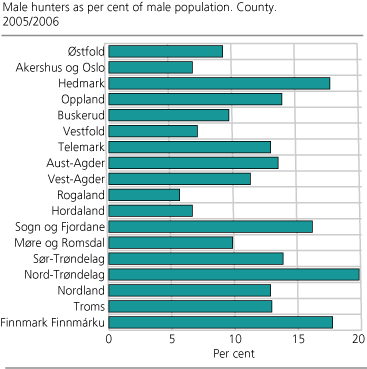Content
Published:
This is an archived release.
Less hunters passed the hunting test
10 950 persons passed the hunting test in the hunting year 2005/2006. This is 5 per cent less than the year before.
Women account for 23 per cent of all persons who passed the hunting test. Every person that wants to hunt game in Norway, has to pass the hunting test before she or he can start hunting.
For the hunting year 2005/2006 a number of 195 200 persons paid the hunting tax, of whom 2 900 lived abroad. Of the 192 200 persons living in Norway, 11 800 were women.
Almost 405 000 persons are registered in the official Register of hunters. Of these, 8 100 are foreign hunters.
Every tenth person a hunter
The county of Nord-Trøndelag still has the highest frequency of hunters in proportion to its population. Here, every fifth male inhabitant over 16 years bought a hunting tax card in 2005/2006. Rogaland had the lowest proportion of hunters, counting 6 per cent of the population. For Norway as a whole, 10 per cent of the male population paid the hunting tax.
The fact that a person bought a hunting tax card does not necessarily mean he or she actually went hunting. 75 per cent reported being active hunters in 2004/05. Of all active hunters, 67 per cent participated in small game hunting and 58 per cent hunted cervids (see Active hunters ).
Half of all foreign hunters are Nordic
2 900 foreign hunters paid hunting tax to Norway, including 600 Norwegians living abroad. 52 per cent of foreign hunters came from other Nordic countries. Of the foreign hunters, 33 per cent were from Denmark, 18 per cent from Sweden and 12 per cent from Germany.
The statistics are published annually.
Tables:
- Table 1 Hunters buying hunting tax card. 1995/1996-2005/2006
- Table 2 Hunters passed hunting test. 1998/1999-2005/2006
- Table 3 Hunters by age and sex. 2005/2006
- Table 4 Hunters by county of residence. 2005/2006
- Table 5 Hunters as per cent of population over 16 years
- Table 6 Persons listed in the Register of hunters
- Table 7 Hunters living abroad buying hunting tax card in Norway. 2001/2002-2005/2006
Contact
-
Terje Olav Rundtom
E-mail: terje.olav.rundtom@ssb.no
tel.: (+47) 91 38 60 61


